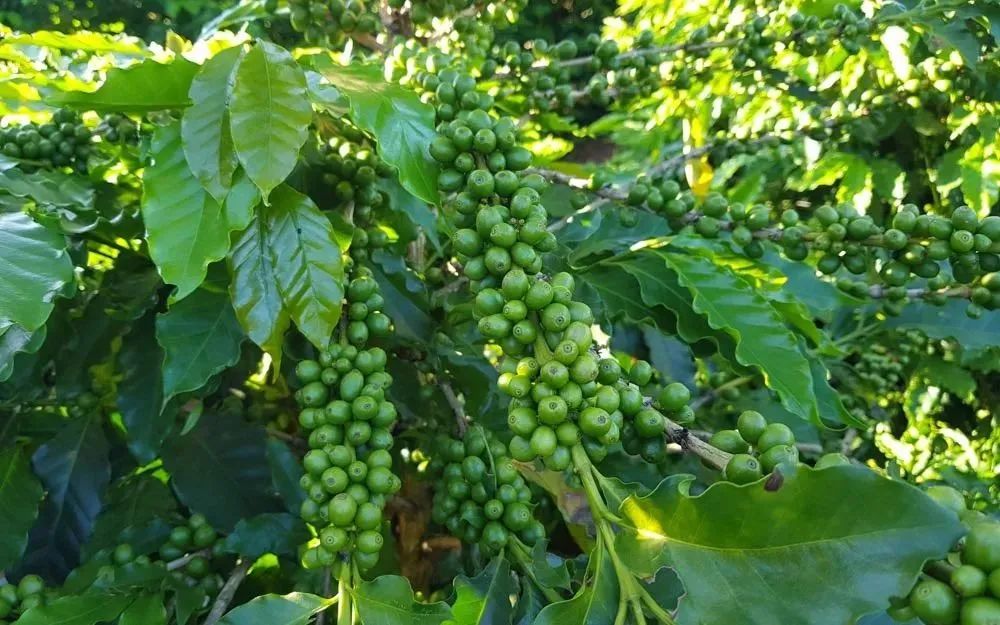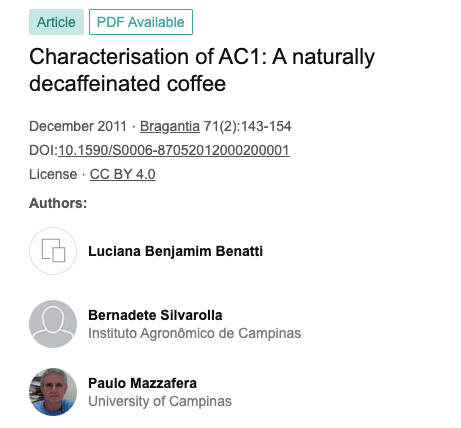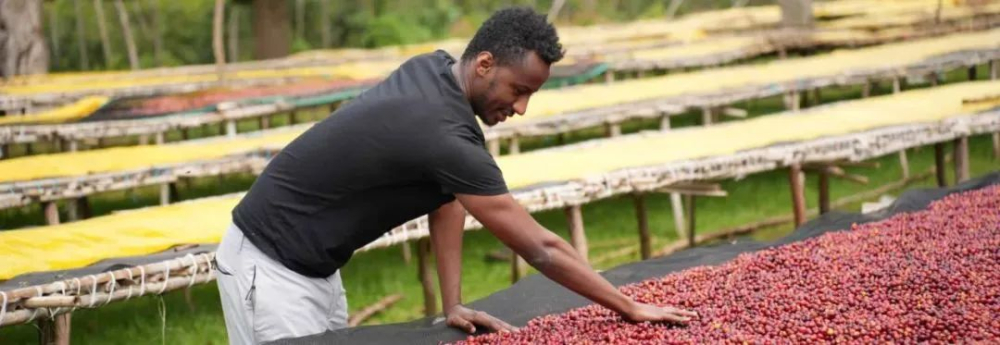Introduction of Brazilian natural decaf coffee variety AC1
Nowadays, as more and more people become interested in natural decaf coffee, decaf coffee appears more and more frequently, both in stores and in the auction houses of fine coffee and raw beans. Such as Laurina and Aramosa, as well as the Ethiopian variety AC1 that has been excavated in recent years.
What is AC1?
It is understood that the common Arabica varieties on the market, the caffeine content is about 8-12mg/g, while the caffeine content of AC1 is only about 0.76mg/g, which is a natural low-caffeine coffee variety.

Where does the AC1 variety come from?
According to an interview with Perfect Daily Grind, about 60 years ago, the Food and Agriculture Organization of the United Nations went to Ethiopia, the birthplace of coffee, collected 621 Arabica seed classifications and shared them with research institutions around the world, including the Costa Rican Tropical Agriculture Research and Education Center (CATIE).

In 1973, Dr Alcides Carvalho of the Brazilian Institute of Agronomy (IAC) asked FAO to send some seeds to CATIE to be planted on the local San Eliza farm in Campinas. About 26 years later, IAC's Maria Bernadete Silvarolla found three varieties with very low caffeine content in these beans, namely AC1,AC2,AC3.
IAC researcher Julio Mistro said, "compared to other varieties of coffee, AC1 has higher plants, fewer branches and lower yield of coffee beans. Although it is not susceptible to leaf rust, it is very intolerant to high temperature and dryness. "
Research on AC1
In 2011, in a study entitled "characteristics of AC1: natural decaf", IAC researchers compared two coffee varieties, AC1 and Mundo Novo (New World).

The New World, a natural hybrid of Sumatran iron pickup and Bourbon, was discovered in Brazil in the 1940s and is now popular there. The comparison with New World is chosen because it has a low caffeine content, accounting for only 1: 1.2%.
The researchers compared the two beans in terms of fruit growth, sugars, organic acids, amino acids and phenolic compounds. Although the coffee fruit of AC1 is smaller than that of New World, there are many similarities in their chemical composition. Finally, according to the research results, AC1 is a potential variety and is likely to have a place in the global coffee market.
Will decaf become a new trend in the market?
In the industry, natural decaf coffee is still a relatively new concept, and its heat is far less than that of artificial decaf coffee.
For most consumers, although they know that moderate consumption of caffeine is harmless, there are still many reasons why people are more likely to choose decaffeinated or decaffeinated coffee, such as rapid heart rate and insomnia. But at the same time, they will worry about whether the process of manual caffeine removal will cause health problems.

The possibility of mass production of AC1
In boutique coffee, natural low-caffeine beans are attracting more and more people's interest, so is AC1 likely to become the next popular decaf variety?
To get a more accurate answer, you need to wait for further research by professionals, but it is clear that low caffeine levels are not conducive to the growth of low-caffeine varieties, including AC1. For coffee plants, caffeine can effectively prevent insect pests, that is, the lower the caffeine content, the easier it is to wither. Therefore, at present, only high-quality coffee roasters and some consumers are interested in decaf coffee, and coffee producers do not have many ideas.

"the Brazilian Institute of Agronomy does not recommend putting AC1 into commercial production, and we have never used AC1 for commercial cultivation." "compared with other coffee varieties in Brazil, growing AC1 requires finer treatment, more adequate fertilization and irrigation, as well as enhanced care conditions such as weeding, deworming and pest control," Julio said. This also means that higher cost inputs are required, but even if these measures are strictly implemented, AC1 production will still be very low.
However, considering the advantages of AC1 and other natural low-caffeine varieties, the institute used other high-quality varieties to pollinate AC1, such as Kaduai and New World, Julio explained. "then the new varieties we bred not only have high yields, but also contain only 0.03% to 0.1% caffeine."
At present, the new varieties discovered are conducting regional trials to select the ones most suitable for commercial production, and it will take about 6 to 7 years to complete these trials.
Disclaimer: some of the pictures in this article come from the network, and some of the contents of the website, such as pictures, we will respect the origin of the original copyright, but due to the large number, there will be individual pictures and texts not in time to indicate, please forgive me. If the original author has any disputes can contact the website to deal with, once verified, we will immediately correct, by "Ka comment vdailycom" collation and editing, reprint please indicate, this article is intended to spread coffee culture, if infringement, please inform to delete, thank you ~!

Important Notice :
前街咖啡 FrontStreet Coffee has moved to new addredd:
FrontStreet Coffee Address: 315,Donghua East Road,GuangZhou
Tel:020 38364473
- Prev

Honey Snow Ice City says it will tie the diner to the overpass for 8 hours!
According to the release of Finance and Economics, recently, Guangzhou, Guangdong. Some netizens found that a restaurant in Honey Snow Ice City had handwritten a warning of stealing food, saying that the thief would be "tied to an overpass for eight hours" and "poured ten buckets of milk tea on his head", and the video of stealing food would be posted online. As soon as the matter broke, it went viral. Read seconds to inquire about Honey Snow Ice City
- Next

"Should we not sell Espresso?"
▲ Click to follow| Daily Coffee Culture Magazine Coffee Workshop As a national drink in Italy, locals believe that only the rich and fragrant taste of Espresso meets the coffee setting. Standing at the bar and swallowing a small glass of espresso is also a daily pastime for every Italian. in China
Related
- Is espresso stored overnight in the refrigerator harmful to your body? Is frozen coffee better than freshly ground coffee?
- What parameters and proportions of water temperature should be used to grind and brew fresh coffee beans? Why can't I drink freshly roasted coffee right away?
- Customers have "changed" Manner's new products! Shop assistant: Please don't mess around!
- Remove sockets in customer areas at Starbucks stores?! Netizen: I won't go if I really tear it down
- What is the difference between the taste steps of sun-dried coffee and washed coffee? Why is sun-cured coffee sweeter and washed coffee sour?
- The recipe for salty grapefruit dirty is revealed! Coffee Festival salty grapefruit dirty coffee making materials parameters ratio milk share!
- How about the flavor of Sunlight 74158 at Sidamo Banshaha Mathieu Processing Factory in Ethiopia? 74158 Share the proportion of coffee brewing parameters!
- What effect does Italian American coffee with filter paper have? Will coffee taste better if it is put on filter paper at the bottom of the powder bowl?
- What is the color difference in coffee beans? What are the characteristics of honey processed coffee beans? Why are the anaerobically treated coffee beans uneven in color?
- How does novice Xiaobai quickly get started and make coffee? Newbies learn to make coffee by hand and share the specific steps and process process!

